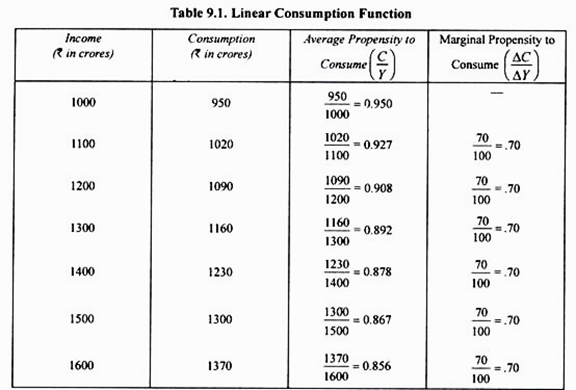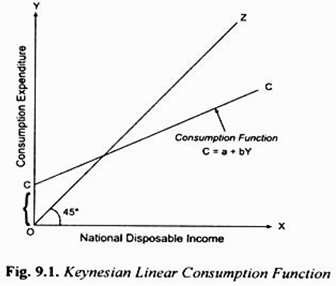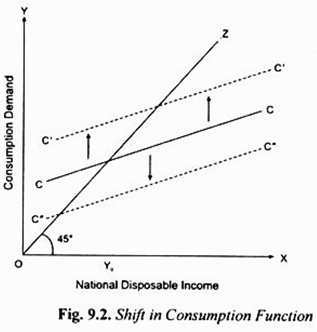Let us make in-depth study of the concept and features of consumption function of a community.
Concept of Consumption Function:
As the demand for a good depends upon its price, similarly consumption of a community depends upon the level of income.
In other words, consumption is a function of income. The consumption function relates the amount of consumption to the level of income.
When the income of a community rises, consumption also rises. How much consumption rises in response to a given increase in income depends upon the marginal propensity to consume. It should be borne in mind that the consumption function is the whole schedule which describes the amounts of consumption at various levels of income. We give in Table 9.1 such a schedule of consumption function.
Consumption function should be carefully distinguished from the amount of consumption. By consumption function is meant the whole schedule which shows consumption at various levels of income, whereas amount of consumption means the amount consumed at a specific level of income.
The schedule described above reflects the consumption function of a community i. e., it indicates how the consumption changes in response to the change in income. In the consumption schedule given in Table 9.1 it will be seen that at the level of income equal to Rs. 1200 crores, the amount of consumption is Rs. 1090 crores.
As the national income increases to Rs. 1500 crores, the amount of consumption rises to Rs. 1300 crore, consumption function remaining the same. Thus, with a given consumption function, amount of consumption is different at different levels of income.
The above schedule of consumption function reveals an important fact that when income rises, consumption also rises but not as much as the income. This fact about consumption function was emphasized by Keynes, who first of all evolved the concept of consumption function.
ADVERTISEMENTS:
The reason why consumption rises less than income is that a part of the increment in income is saved. Therefore, we see that when income increases from Rs. 1000 crores to Rs. 1100 crores, the amount of consumption rises from Rs. 950 crores to 1020 crores. Thus, with the increase in income by Rs. 100 crores, consumption rises by Rs. 70 crores; the remaining Rs. 30 crores are saved. Similarly, when income rises from Rs. 1100 crores to Rs. 1200 crores, the amount of consumption increases from Rs. 1020 crores to Rs. 1090 crores.
Here also, as a result of increase in income by Rs. 100, the amount of consumption has risen by Rs. 70 crores and the remaining Rs. 30 crores have been saved. The same applies to further increases in income and consumption. We shall see later that Keynes based his theory of multiplier on the proposition that consumption increases less than the increase in income and this theory of multiplier occupies an important place in macroeconomics.
Consumption demand depends on income and propensity to consume. Propensity to consume depends on various factors such as price level, interest rate, stock of wealth and several subjective factors. Since Keynes was concerned with short-run consumption function he assumed price level, interest rate, stock of wealth etc. constant in his theory of consumption. Thus with these factors being assumed constant in the short run, Keynesian consumption function considers consumption as a function of income. Thus
C = f (Y)
ADVERTISEMENTS:
In a specific form, Keynesian function can be written as:
C = a + bY
where a and b are constants. While a is intercept term of the consumption function, b stands for the slope of the consumption function and therefore represents marginal propensity to consume.
Keynesian consumption function has been depicted by CC curve in Fig. 9.1 in which along the Y-axis national income is measured and along the K-axis the amount of consumption is measured. In Figure 9.1 a line OZ making 45° angle with the X-axis has been drawn. Because line OZ makes 45° angle with the X-axis every point on it is equidistant from both the X-axis and T-axis. Therefore, if consumption function curve coincides with 45° line OZ it would imply that the amount of consumption is equal to the income at every level of income.
In this case, with the increase in income, consumption would also increase by the same amount. In actual practice consumption increases less than the increase in income. Therefore, in actual practice the curve depicting the consumption function will deviate from the 45° line. If we represent the above consumption schedule by a curve, we would get the propensity to consume curve such as CC in Fig. 9.1.
It is evident from this figure that the consumption function curve CC deviates from the 45° line OZ. At lower levels of income, the consumption function curve CC lies above the OZ line, signifying that at these lower levels of income consumption is greater than the income. It is so because at lower levels of income; a nation may draw upon its accumulated savings to maintain its consumption standard or it may borrow from others.
As income increases, consumption also increases and at the income level OY0, consumption is equal to income. Beyond this, with the increase in income, consumption increases but less than the increase in income and therefore, consumption function curve CC lies below the 45° line OZ beyond Y0.
An important point to be noted here is that beyond the level of income OY0, the gap between consumption and income is widening. The difference between consumption and income represents savings. Therefore, with the increase in income, saving gap widens and, as we shall see later, this has a significant implication in macroeconomics.
ADVERTISEMENTS:
It is useful to point out here that when the consumption function of a community changes, the whole consumption function curve changes or shifts. When propensity to consume increases, it means that at various levels of income more is consumed than before. Therefore, as a result of increase in propensity to consume of the community, the whole consumption function curve shifts upward as has been shown by the upper curve C’C in Fig. 9.2. On the contrary, when the propensity to consume of the community decreases, the whole consumption function curve shifts downward signifying that at various levels of income, less is consumed than before.
Important Features of Keynes’ Consumption Function:
In macroeconomics, Keynes’s consumption function plays a highly important role. Therefore, it is essential to state its important features.
The following are the important features of Keynes’s consumption function:
ADVERTISEMENTS:
1. First, absolute level of current income is the important factor that determines consumption of the community. Increase in national income causes an increase in consumption. On the other hand, classical economists thought that it was rate of interest that primarily determined saving and consumption of the community.
A rise in rate of interest induces the people to save more and thus to reduce their level of consumption. According to Keynes, though rate of interest is one of the factors that determine consumption of the community, he did not consider it a very important determinant of it. By considering level of current income as the most important factor determining consumption and saving, Keynes made a significant contribution to the macroeconomic theory.
2. The second important feature of Keynes’ consumption function is that marginal propensity to consume is less than one but greater than zero (0 < MPC < 1). The feature of Keynes’s consumption function that marginal propensity to consume is less than one is known as Keynes’s Psychological Law of Consumption. According to this law, as income increases, consumption increases but not as much as the increase in income.
3. In Keynes’ consumption function, namely, C = a + bY, as income increases, average propensity to consume (APC) falls. Keynes was of the view that rich people relatively save a higher proportion of their income so that at higher levels of income average propensity to consume (APC), that is, proportion of total consumption to national income falls as national income rises.
ADVERTISEMENTS:
4. Another important feature of consumption function as put forward by Keynes is that it remains stable in the short run. Consumption function, according to Keynes, depends on various institutional factors such as distribution of income and wealth and psychological factors such as willingness to save.
Since there cannot be much changes in these institutional and psychological factors, consumption function remains stable in the short run, that is, it does not shift upward or downward. Therefore, Keynes in his theory, explains the determination of income and employment in the short run by considering that the consumption function is stable.


